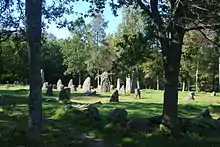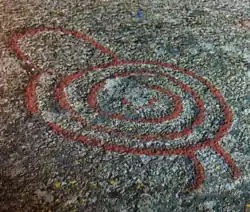Istrehågan
Istrehågan is an ancient monument at Jåberg on the Sandefjord-Larvik border in Vestfold og Telemark, Norway.[3][2] It is home to some of the largest stone settings in the Nordic Countries.[4] Nearby Haugen farm in Sandefjord is home to Vestfold County's largest petroglyph site.[5] The rock carvings at Haugen farm are Vestfold County's oldest ancient monument.[6] It is an ancient burial ground which dates to the time of the Roman Iron Age around 1500-500 BCE.[7] It is located two kilometers northwest of Hemskilen Nature Preserve in a forest known as Marumskogen.[8]

Large stone settings resemble a ship. The largest "ship" is 24 metres (79 ft) long, and 9 metres (30 ft) meters broad. Most rocks are about 1 metre (3 ft 3 in) tall, while some are as high as 4.5 metres (15 ft). Archaeological excavations made in 1959-1961 uncovered remains of bones, bear claws, pottery shards, a brooch, and more.[9][10] [11] Most stone settings are dated to the Migration Period around 400-500 A.D. There are marked hiking trails leading to Istrehågan through the Marum forest, for example from Store Bergan skole. There are also agricultural symbols here which were etched into the hillside during the Bronze Age, 1500-500 B.C.E.[12] [13]
Stone settings

There are various stone settings, including settings depicting several ships and circles. The stone settings are dated to 400-500 A.D.[3][2]
Istrehågan has been named one of the most magnificent stone settings in the Nordic Countries. A burial mound with large stone settings were put up here during the Great Migration over 1,500 years ago. The largest stone setting resembles a ship and is 25 meters in length. Some stones are as tall as 4.5 meters. The width is 9 meters. The rolling lines of the gunwales are marked explicitly by the falling height of the rocks towards "midship." It is erected with tall stones at each end marking bow and stern.[4]
Istrehåg's stone settings are similar to the stone settlements on the continent and on the British Isles. It is a protected cultural heritage area which is managed by the Museum of Cultural History at the University of Oslo.[14][15][16]
References
- Lund, Arild and Charlotte Jørgensen (2001). Larvik. Capella Media. Page 16. ISBN 978-8299606912.
- Davidsen, Roger (2008). Et Sted i Sandefjord. Sandar Historielag. Page 144. ISBN 9788299456753.
- Jøranlid, Marianne (1996). 40 trivelige turer i Sandefjord og omegn. Vett Viten. Page 123. ISBN 9788241202841.
- Bertelsen, Hans Kristian (1998). Bli kjent med Vestfold / Become acquainted with Vestfold. Stavanger Offset AS. Page 94. ISBN 9788290636017.
- Børresen, Svein E. (2004). Vestfoldboka: en reise i kultur og natur. Skagerrak forl. Page 38. ISBN 9788292284070.
- Tollnes, Ivar and Olaf Akselsen (1994). Sandefjord: Den lille storbyen. Sandefjords blad. Page 102. ISBN 9788299070447.
- "Rock carvings and standing stones at Haugen Farm". www.visitvestfold.com.
- Aadnevik, Kjell-Einar (2019). Turguide til Larvik og Omegn. Dreyers forlag. Page 136. ISBN 9788282654418.
- Istrehågan - A Ship of Stone (The Viking Trail, page 8. Vestfold fylkeskommune).
- Mæhlum, Lars (29 September 2014). "Istrehågan" – via Store norske leksikon.
- Istrehågan, A ship of stone (The Viking Trail through Vestfold. Page 7. Vestfold fylkeskommune).
- Tollnes, Ivar and Olaf Akselsen (1994). Sandefjord: Den lille storbyen. Sandefjords blad. Page 100. ISBN 9788299070447.
- "Store Bergan skole". Sandefjord kommune. Retrieved September 1, 2018.
- Tore, Sandberg and Cato Arveschoug (2001). Sandefjord zoomet inn av fotograf Tore Sandberg. C. Arveschoug and Magne Helland. Page 6. ISBN 9788299616706.
- "Istrehågan er Vestfolds Stonehenge". 17 July 2015.
- Tørrestad, Yngve. "Vestfolds svar på Stonehenge".
External links
- Istrehagan (Vestfold fylkeskommune)
.jpg.webp)